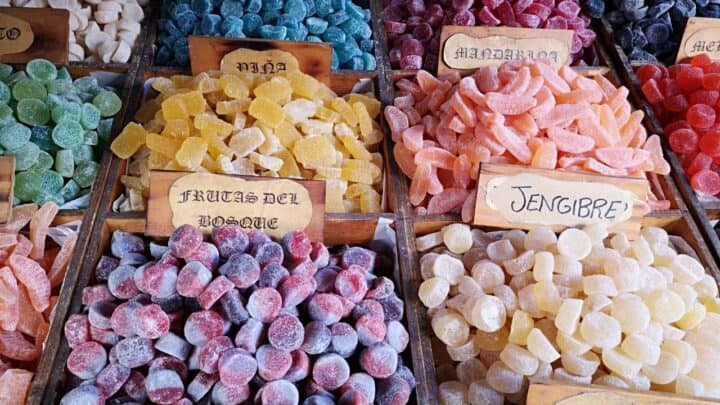Just about everyone likes candy, but does everyone like “candy” or “candies”?
When do you use one word and when do you use the other?
It’s easy to figure this out when you have a regular noun like apple, which becomes plural when you add an “s” on the end.
It gets more confusing with a word like “candy,” which can mean one piece of candy or a whole lot of candy or all the candy in the world!
If it can do all those things, why do you need the word “candies” as well?
Keep reading and we’ll clear it all up for you.
Should you use “candy” or “candies”?
“Candy” can be a countable or uncountable noun. It may refer to a single piece, all candy or a group of candies. You can use “candies” to refer to several pieces of a specific type or a collection of candy.
Candy or candies: Understanding countable and uncountable nouns
To understand when and how to use “candy” and “candies,” you need to understand countable and uncountable nouns since “candy” can be used in both of these ways.
In general, countable nouns are things you can physically count. Examples would be chairs, cats, shirts or balls.
Uncountable nouns are generally things that you can’t count. Examples would be milk, snow and water.
Many abstract ideas are also uncountable, like compassion or peace.
With countable nouns, you add “s” when there is more than one. With uncountable nouns, you generally speak about them without the “s.”
Here’s are some examples that show the difference between “cucumber,” a countable noun, and “milk,” an uncountable noun:
There are cucumbers in the refrigerator.
There is milk in the refrigerator.
However, there are times when you might use an uncountable noun as a countable noun.
Think about milk. Most of the time, you would use it as an uncountable noun.
“You should drink some milk.”
But what if you are ordering three glasses of milk in a restaurant, or you are referring to four cartons of milk in the refrigerator?
Sometimes, you might drop the “glasses of” or “cartons of” and just say “three milks” or “four milks.”
However, the milk must always be in separate packages to refer to it this way. You would never say “milks” if you were talking about milk in a single container.
Another thing to understand about countable and uncountable nouns is that some adjectives only modify one type of noun.
“Much” only goes with uncountable nouns while “many” is always paired with countable nouns:
There are not many milks left on the shelf at the grocery store.
“Little” only goes with uncountable nouns. “Few” goes with countable nouns.
There are just a few milks left.
Now, let’s take a look at “candy” and “candies.”
The meaning of “candy” and “candies” in sentences
First, when in doubt, use “candy” instead of “candies” and you will virtually always be correct.
“Candy” refers to the broad category of items, and you would use it when you are talking about the items in general.
It can also be used in the singular sense as a shortened version of “a piece of candy” when you are talking about only one.
You might say “candies” if you are specifically referring to certain individual pieces.
One other thing it might be useful to know is that “candy” is American English. In British English, the word would be “sweet” or “sweets,” and it’s a regular countable noun.
Examples of “candy” and “candies” in sentences
It’s helpful if we can look at examples of these words in a sentence.
Most of the time, “candy” is the right word to use.
You should use it when you are talking about the class of “candy” in general:
Marshall doesn’t like candy.
You must also use “candy” with the adjectives “much” or “little”:
I hope no more trick-or-treaters come because there isn’t much candy left.
From now on, it’s first come, first served because we only have a little candy.
And you could use “candy” in most other situations as well:
He gave Danielle a box of candy.
They gave me candy.
However, there are a few situations in which you could use “candy” or “candies.”
For example, if you have some pieces of candy, you might use the words interchangeably. However, note that you need to change the sentence to be singular for “candy” and plural for “candies”:
Do you want these candies?
“Candy” would still be more common, but you could use “candies” to emphasize that you really wanted them to take all of them.
“Candies” would be good to use if you were emphasizing the individual pieces.
For example, if you worked in a store that sold homemade pieces of candy and you only had three left, you might use “candies.” Remember also that “many” goes with countable nouns, so you could only use it with “candies”:
You might also use “candies” if you wanted to emphasize that you had several different types:
Look at the different candies in this box.
With the adjective “few,” you must use “candies”:
The last word on “candy” and “candies”
In conclusion, the distinction between “candy” and “candies” can be a subtle one.
When talking about candy in a general sense or when paired with the adjectives “much” or “little,” you must use “candy” while you must use “candies” with “many” and “few.”
However, when it comes to talking about some specific pieces of candy, the distinction is less clear, even for native speakers of English.
Most people would still say “candy,” but “candies” is not necessarily wrong in that situation.

Hey fellow Linguaholics! It’s me, Marcel. I am the proud owner of linguaholic.com. Languages have always been my passion and I have studied Linguistics, Computational Linguistics and Sinology at the University of Zurich. It is my utmost pleasure to share with all of you guys what I know about languages and linguistics in general.

